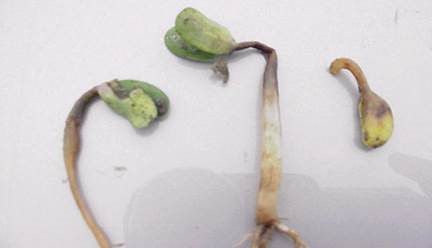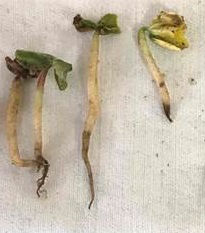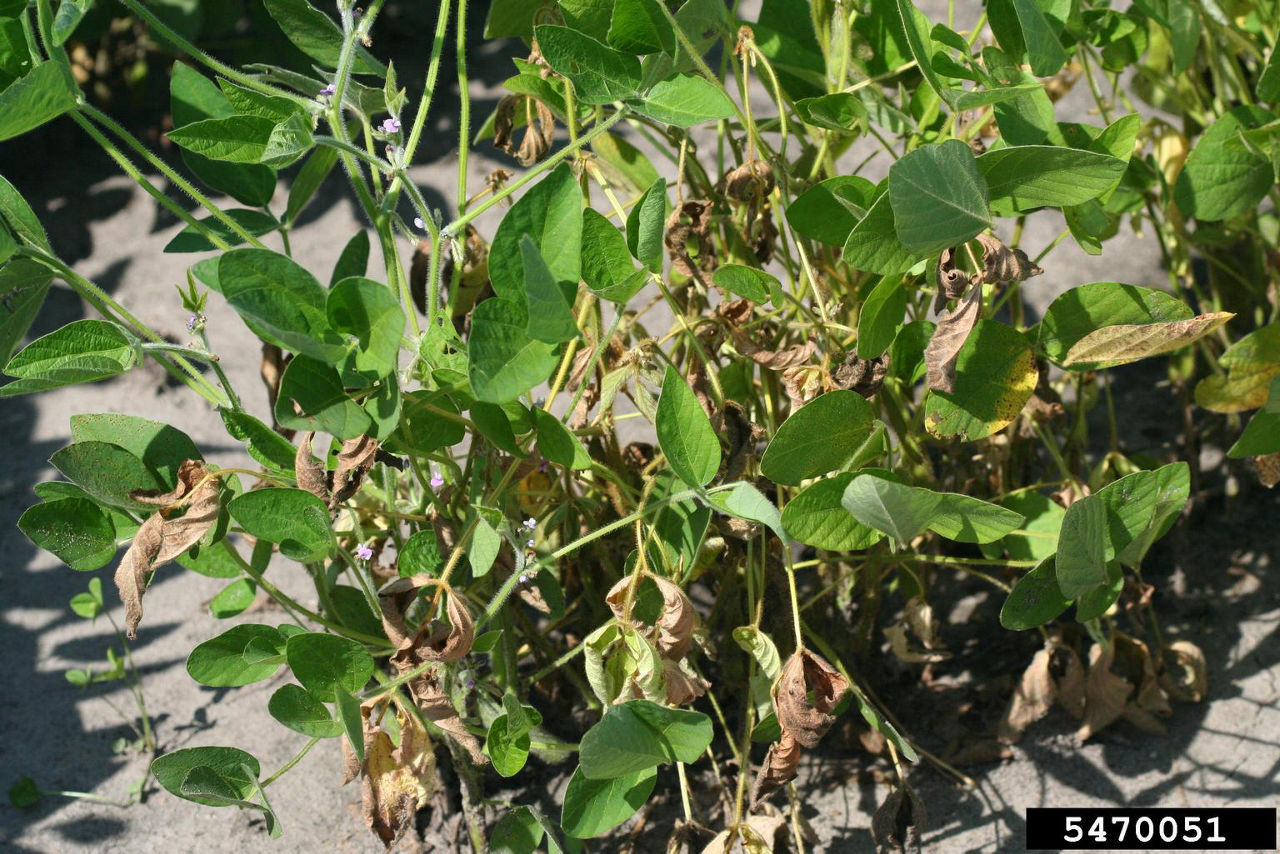3 MIN READ
Early Season Hazards to Soybean Seed
October 10, 2023
Seedbed Conditions in Early-Spring
A greater harvest of sun energy can lead to a greater potential yield. Earlier soybean planting dates have become a common cultural practice to increase the number of pods for high-yield soybean production. However, the potential gains in soybean yield can be compromised early in the season by environmental stresses and a complex of soil-borne pathogens that can negatively affect root health and seedling vigor.
Germination and emergence are rapid at temperatures above 77 °F, but seeds can germinate at lower temperatures.1 Cool (less than 60 °F) and moist soil conditions, especially in heavy residue, can slow germination and establishment of soybean seeds, making them more susceptible to soilborne seed and seedling pathogens such as Pythium and some Fusarium species. Warm, moist soil environments favor the pathogens Rhizoctonia, Phytophthora, and other Fusarium species. Any of these pathogens can invade seeds and plant roots, causing tissue decay, pre-emergence damping off, and early post-emergence seedling death.
Chilling or Cold Injury
Chilling injury can occur when there is a drastic change in the water temperature as the seed absorbs water (imbibition). This typically occurs when soybean seed imbibes water that is under 45 °F in the first 6 to 24 hours after planting. Imbibitional chilling is often associated with a cold front that brings not only colder temperatures but also cold rainfall within 24 hours of planting. Cold injury can happen when there is a rapid drop in soil temperature after the seed has imbibed water, usually more than 24 hours after planting.6
Soybean Seedling Diseases
Soybean seedling diseases can be hard to detect and a challenge to distinguish from one another (Figure 1). A look at seedlings affected by chilling injury, water-logged soils, or disease can leave a scout with more questions than answers.
Prior to emergence, seeds are exposed to indigenous pathogens. Some of these pathogens, like Phytophthora, can live in the soil for up to ten years.2 Pythium “lays in wait” to begin the infection cycle until soybean seed is detected during a time of excess soil water.3 Further complicating the fight to protect soybean against disease is the tendency for different races or strains of the pathogenic species to thrive in certain conditions. For example, Fusarium seed and seedling blight is caused by several pathogen species, some of which prefer warm and dry soil, while others prefer wet and cool soil.
- Pythium is a soil-borne, fungal-like organism that can cause decay before germination, and infected soybean seeds become soft and rotten. Infected seedlings may die prior to emerging from the soil or shortly thereafter. Those that do emerge often display poor root development and yellow or tan lesions on the hypocotyl (Figure 1A). The key environmental factor for Pythium pathogens is excessive water resulting in saturated soil, regardless of temperature, although many species of Pythium do prefer cool conditions.2,3
- Rhizoctonia solani is a true fungus and can cause seed decay with early infections. Infected seedlings that survive through emergence typically show dark reddish-brown lesions on the hypocotyl (Figure 1B) just above the soil surface.3,4
- Phytophthora sojae is a fungus-like species which causes a wet, soft rot of the seed or seedling tissue similar to that caused by Pythium (Figure 1C). P. sojae favors warmer soil temperature and can be spread by water. As previously mentioned, these organisms are capable of surviving in the soil for up to ten years in the absence of a host. Soybean is the only known host for this pathogen.2,3
- Fusarium infection is caused by a complex of different species that prefer a wide range of soil moisture and temperature conditions. These species’ host range also includes corn and wheat. Fusarium may infect soybean plants early in the growing season, but plants sometimes do not display symptoms until later in the growing season when soil moisture is limited. Symptoms include a brown- to black-colored taproot and lateral roots, internal root and stem rot, as well as wilted leaves (Figure 2).2



Figure 1. Soybean seedling diseases are hard to distinguish from one another. Here, seedlings are being affected by (A) Pythium, (B) Rhizoctonia, and (C) Phytophthora. Photo C courtesy of Dean Malvick, University of Minnesota.

Seed Treatment Products for Soybean
Seed treatments can help minimize the effect of seed and seedling diseases. Seed treatments with multiple modes of action can provide broad-spectrum control of diseases and insects. Improved plant health can result in better emergence of seedlings under suboptimal soil conditions. Some active ingredients in soybean seed treatments can protect soybean seeds and seedlings from certain diseases and insects for up to 30 days after planting. Protecting soybean plants against attack by early season insects, including soybean aphids and bean leaf beetles, can help prevent soybean mosaic virus and bean pod mottle virus infection that can be transmitted by these pests.
The greatest potential payback from using a seed treatment can occur in fields with wet soil conditions or those with a known history of the disease. Wet soil conditions may be due to early planting, reduced tillage, poor drainage, topography, or high clay content. Seed treatments are intended to protect emerging seedlings for two to three weeks until they become established. Knowledge of any specific pathogen races prevailing in the soil can be helpful when selecting soybean products to provide an additional line of defense against early season diseases. The value of a robust seed treatment in combination with seed products having strong emergence and seedling vigor scores can help give seedlings a fighting chance against variable, and sometimes harsh, early spring conditions.
In addition to seed treatment products, cultural practices such as lengthening rotation intervals to a non-host crop for perhaps three to four years can help to decrease the pathogen population. Tillage is also an option to help reduce the chances of disease infection, although other effects from tillage should also be taken into consideration as well.5
Sources:
1 Soybean planting date can have a significant impact on yield. Iowa State University Extension and Outreach. https://crops.extension.iastate.edu/encyclopedia/soybean-planting-date-can-have-significant-impact-yield
2 Malvick, D. 2018. Soybean seed and seedling diseases. University of Minnesota Extension. https://extension.umn.edu/soybean-pest-management/soybean-seed-and-seedling-diseases
3 Pythium- an early season pain in corn and soybeans. Illinois Field Crop Disease Hub. http://cropdisease.cropsciences.illinois.edu/?p=1071
4 Joyce, A. and Thiessen, L. 2020. Soybean seedling diseases. North Carolina State Extension. https://content.ces.ncsu.edu/soybean-seedling-diseases?x=10600
5 Ruden, K. 2013. Chapter 8: Fungicidal seed treatments for soybeans. iGrow Soybean. South Dakota State University Extension. https://extension.sdstate.edu/sites/default/files/2020-03/S-0004-08-Soybean.pdf
6 Licht, M. Imbibitional chilling or cold injury. Iowa State University Extension and Outreach. Integrated Crop Management. https://crops.extension.iastate.edu/encyclopedia/imbibitional-chilling-or-cold-injury
Web sources verified 9/29/2023. 1316_100069